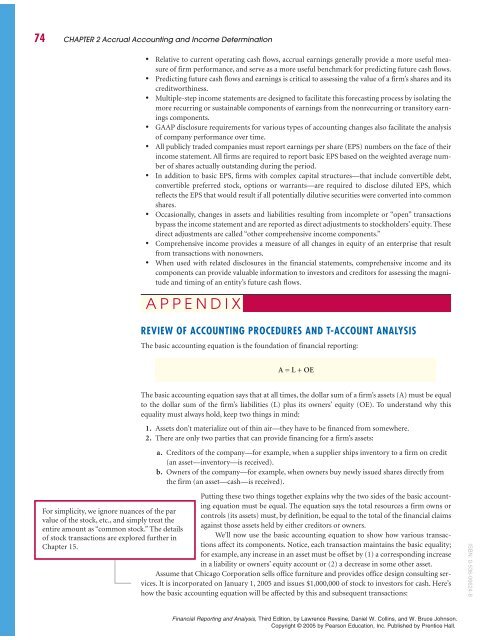Accrual Accounting and Income Determination - Pearson Learning ...
Accrual Accounting and Income Determination - Pearson Learning ...
Accrual Accounting and Income Determination - Pearson Learning ...
You also want an ePaper? Increase the reach of your titles
YUMPU automatically turns print PDFs into web optimized ePapers that Google loves.
74 CHAPTER 2 <strong>Accrual</strong> <strong>Accounting</strong> <strong>and</strong> <strong>Income</strong> <strong>Determination</strong>• Relative to current operating cash flows, accrual earnings generally provide a more useful measureof firm performance, <strong>and</strong> serve as a more useful benchmark for predicting future cash flows.• Predicting future cash flows <strong>and</strong> earnings is critical to assessing the value of a firm’s shares <strong>and</strong> itscreditworthiness.• Multiple-step income statements are designed to facilitate this forecasting process by isolating themore recurring or sustainable components of earnings from the nonrecurring or transitory earningscomponents.• GAAP disclosure requirements for various types of accounting changes also facilitate the analysisof company performance over time.• All publicly traded companies must report earnings per share (EPS) numbers on the face of theirincome statement. All firms are required to report basic EPS based on the weighted average numberof shares actually outst<strong>and</strong>ing during the period.• In addition to basic EPS, firms with complex capital structures—that include convertible debt,convertible preferred stock, options or warrants—are required to disclose diluted EPS, whichreflects the EPS that would result if all potentially dilutive securities were converted into commonshares.• Occasionally, changes in assets <strong>and</strong> liabilities resulting from incomplete or “open” transactionsbypass the income statement <strong>and</strong> are reported as direct adjustments to stockholders’ equity. Thesedirect adjustments are called “other comprehensive income components.”• Comprehensive income provides a measure of all changes in equity of an enterprise that resultfrom transactions with nonowners.• When used with related disclosures in the financial statements, comprehensive income <strong>and</strong> itscomponents can provide valuable information to investors <strong>and</strong> creditors for assessing the magnitude<strong>and</strong> timing of an entity’s future cash flows.APPENDIXREVIEW OF ACCOUNTING PROCEDURES AND T-ACCOUNT ANALYSISThe basic accounting equation is the foundation of financial reporting:A = L + OEThe basic accounting equation says that at all times, the dollar sum of a firm’s assets (A) must be equalto the dollar sum of the firm’s liabilities (L) plus its owners’ equity (OE). To underst<strong>and</strong> why thisequality must always hold, keep two things in mind:1. Assets don’t materialize out of thin air—they have to be financed from somewhere.2. There are only two parties that can provide financing for a firm’s assets:a. Creditors of the company—for example, when a supplier ships inventory to a firm on credit(an asset—inventory—is received).b. Owners of the company—for example, when owners buy newly issued shares directly fromthe firm (an asset—cash—is received).Putting these two things together explains why the two sides of the basic accountingequation must be equal. The equation says the total resources a firm owns orFor simplicity, we ignore nuances of the parcontrols (its assets) must, by definition, be equal to the total of the financial claimsvalue of the stock, etc., <strong>and</strong> simply treat theentire amount as “common stock.” The detailsagainst those assets held by either creditors or owners.of stock transactions are explored further inWe’ll now use the basic accounting equation to show how various transactionsaffect its components. Notice, each transaction maintains the basic equality;Chapter 15.for example, any increase in an asset must be offset by (1) a corresponding increasein a liability or owners’ equity account or (2) a decrease in some other asset.Assume that Chicago Corporation sells office furniture <strong>and</strong> provides office design consulting services.It is incorporated on January 1, 2005 <strong>and</strong> issues $1,000,000 of stock to investors for cash. Here’show the basic accounting equation will be affected by this <strong>and</strong> subsequent transactions:ISBN: 0-536-06624-8Financial Reporting <strong>and</strong> Analysis, Third Edition, by Lawrence Revsine, Daniel W. Collins, <strong>and</strong> W. Bruce Johnson.Copyright © 2005 by <strong>Pearson</strong> Education, Inc. Published by Prentice Hall.
















